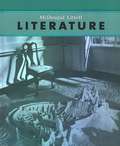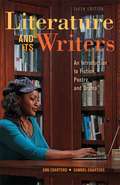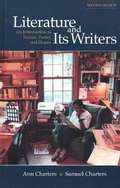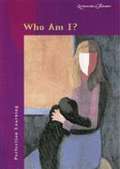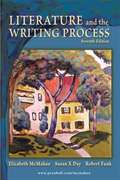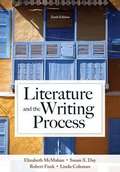- Table View
- List View
Literature [Grade 8]
by Arthur N. Applebee Jim Burke Douglas Carnine Yvette Jackson Judith A. Langer Robert J. Marzano Mary Lou Mccloskey Donna M. Ogle Carol Booth Olson Lydia Stack Carol Ann Tomlinson Robert T. Jiménez Janet Allen et al.NIMAC-sourced textbook
Literature [Grade 8]
by Arthur N. Applebee Jim Burke Douglas Carnine Yvette Jackson Judith A. Langer Robert J. Marzano Mary Lou Mccloskey Donna M. Ogle Carol Booth Olson Lydia Stack Carol Ann Tomlinson Robert T. Jiménez Janet Allen et al.NIMAC-sourced textbook
Literature [Grade 8] (Oklahoma)
by Arthur N. Applebee Jim Burke Douglas Carnine Yvette Jackson Judith A. Langer Robert J. Marzano Mary Lou Mccloskey Donna M. Ogle Carol Booth Olson Lydia Stack Carol Ann Tomlinson Robert T. Jiménez Janet AllenNIMAC-sourced textbook
Literature [Grade 9]
by Arthur N. Applebee Jim Burke Douglas Carnine Yvette Jackson Judith A. Langer Robert J. Marzano Mary Lou Mccloskey Donna M. Ogle Carol Booth Olson Lydia Stack Carol Ann Tomlinson Robert T. Jiménez Janet Allen et al.NIMAC-sourced textbook
Literature [Grade 9]
by Arthur N. Applebee Jim Burke Douglas Carnine Yvette Jackson Judith A. Langer Robert J. Marzano Mary Lou Mccloskey Donna M. Ogle Carol Booth Olson Lydia Stack Carol Ann Tomlinson Robert T. Jiménez Janet AllenNIMAC-sourced textbook
Literature and Its Writers: A Compact Introduction to Fiction, Poetry, and Drama
by Ann Charters Samuel ChartersLiterature is a conversation -- between writers and other writers, and between writers and readers. In Literature and Its Writers, Ann and Samuel Charters complement a rich and varied selection of stories, poems, and plays with an unparalleled array of commentaries about that literature by the writers themselves. Such "writer talk" inspires students to respond as it models ways for them to enter the conversation. In the sixth edition, the Charters continue to entice students to join the conversation, with adventurous and intriguing new literary works, more detailed coverage of literary elements, and more help with reading and writing.
Literature and Its Writers: An Introduction to Fiction, Poetry, and Drama
by Ann Charters Samuel ChartersA compilation of fiction, poetry and drama. The book discusses these works and aspects of reading and writing.
Literature and Language (Grade 8, Level Green)
by James Marshall Arthur N. Applebee Judith A. Langer Andrea B. Bermúdez Susan Hynds Donna E. NortonLiterature and Language is different from other books you have used in two important ways. First, it is organized to help you tie together your study of the language arts--literature, writing, and language. The literature, chosen for its appeal to your life, serves as the starting point for all your learning.
Literature and Language Arts: Essentials of British and World Literature (CA Edition)
by Holt Rinehart Winston StaffA literature book set according to California educational standards.
Literature and Language Arts: Introductory Course
by Holt Rinehart Winston StaffRecommended California approved textbook in the language arts.
Literature and Language: English and World Literature
by Mcdougal Littell CompanyAn anthology of English literature with workshop to improve language skills.
Literature and Thought: Who Am I?
by Julie A. SchumacherThe author through four sections, makes readers think critically and develop a deeper understanding of who they are, with each section addressing a specific thinking skill.
Literature and the Language Arts: Applied English
by EMC CorporationThis book expounds on the importance of applied English-- How to write different types of letters, proposals, memos, business letters, projects, etc.
Literature and the Language Arts: Discovering Literature (2nd Edition)
by EMC CorporationWhen you open your EMC Masterpiece Series textbook, you will find great literature, both classic and contemporary, by a wide variety of authors. You will also find useful step-by-step study strategies for each selection, helpful background information, and activities that allow you to relate the literature to your own experiences and share your point of view.
Literature and the Language Arts: Experiencing Literature (2nd Edition)
by EMC CorporationThe contents of this text are Part One--Genres in Literature: The Folk Tradition, Poetry, Fiction, Drama, Nonfiction, Informational and Visual Media; Part Two--Themes in Literature: The Search for Self, What is Talent?, Relationships, Courage and Perseverance, Journeys and Visions of the Future; Part Three--Language Arts Survey: Reading Resource, Writing Resource, Language, Grammar, and Style Resource, Speaking and Listening Resource, Study and Research Resource, and Applied English Resource, etc.
Literature and the Language Arts: Exporing Literature
by EMC CorporationThis textbook contains great literature; both classic and contemporary, by a wide variety of authors, step-by-step study strategies for each selection, helpful background information, and activities that allow one to relate the literature to their own experiences and share their point of view.
Literature and the Language Arts: Responding to Literature (2nd edition)
by EMC CorporationThis contains sections on the short story, plays, poetry, and the novel, as well as sections on film, writing a research paper and other types of literature-based composition. The book is full of exercises and contains numerous student sample essays.
Literature and the Language Arts: The American Tradition
by EMC CorporationInside this book one will find great literature, both classic and contemporary, by a wide variety of authors. It also contains useful step-by-step study strategies for each selection, helpful background information, and activities that allow one to relate the literature to their own experiences and share their point of view.
Literature and the Language Arts: The British Tradition
by EMC Paradigm Publishing Editorial StaffThe EMC Masterpiece Series, Literature and the Language Arts program is carefully structured to teach all students, even those who are struggling, to read great literature-and even be transformed by it. The book provides: direct, step-by-step guidance for each stage of the writing process professional and student models to help students explore a variety of modes and forms Language, grammar, and style lesson integrated within the writing lesson.
Literature and the Language Arts: Understanding Literature
by EMC CorporationThe Guided Reading program in this EMC Masterpiece Series book gives you tips before, during, and after you read each selection. Read on for a description of the features you will find in your textbook.
Literature and the Language Arts: World Literature
by The Editors at the EMC CorporationIn this text your reading will allow you to explore the cultures of many times and places under a spectrum of chosen topics.
Literature and the Writing Process
by Elizabeth Mcmahan Robert Funk Susan X. DayA literature anthology, rhetoric, and handbook in one. Every chapter of this anthology includes coverage of the writing process to help students write more successfully about literature. The process-oriented instruction shows students how to use writing as a way of studying literature and provides students with the tools to analyze literature on their own. New to this edition: New photographs and images chosen to enhance understanding and appreciation of literature Expanded, updated discussion of researched writing (Chapter 17) Further instruction on the elements of argument and arguing an interpretation (Chapter 2) A new casebook on the poetry and prose of Langston Hughes
Literature and the Writing Process 10th Edition
by Elizabeth Mcmahan Robert Funk Susan X Day Linda S. ColemanLiterature and the Writing Process combines the best elements of a literature anthology with those of a handbook to guide students through the interrelated process of analytical reading and critical writing.
